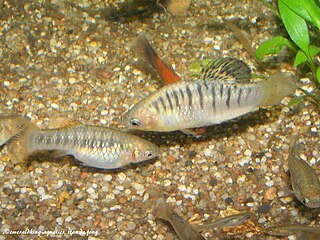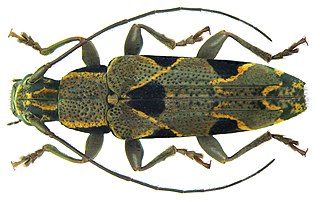
The humpbacked limia or black-barred limia is a critically endangered species of poeciliid fish which is endemic to Haiti. Its common name is derived from the hump males develop as they age. It is sometimes kept in home aquaria.

The blackbanded darter is a species of freshwater ray-finned fish, a darter from the subfamily Etheostomatinae, part of the family Percidae, which also contains the perches, ruffes and pikeperches. It is native to the river systems of the southeastern United States where it is found in the states of Tennessee, Georgia, Florida, Mississippi, Alabama, and Louisiana. It lives over sandy or gravelly bottoms in smaller rivers and streams and its color varies depending on the different habitats in which it lives. It feeds on small insect larvae and is itself preyed on by larger fish. It spawns between February and June depending on locality. It is generally a common fish throughout most of its range.

The black-banded trevally is a species of carangid native to the Indian Ocean, the western Pacific Ocean, and the Atlantic coast of southeastern South Africa. This species inhabits reefs and rocky bottoms at depths from 20 to 150 m. This species grows to 70 cm (28 in) in total length, and the maximum recorded weight reached is 5.2 kg (11 lb). It is of minor importance to local commercial fisheries, but is popular as a gamefish. This species is the only known member of its genus.

Tmesisternini is a tribe of beetles in the subfamily Lamiinae containing the following genera:

Trigonoptera is a genus of longhorn beetles of the subfamily Lamiinae, containing the following species:
Trigonoptera annulicornis is a species of beetle in the family Cerambycidae. It was described by Judson Linsley Gressitt in 1984.
Trigonoptera complicata is a species of beetle in the family Cerambycidae. It was described by Judson Linsley Gressitt in 1984.
Trigonoptera maculifascia is a species of beetle in the family Cerambycidae. It was described by Judson Linsley Gressitt in 1984.
Trigonoptera montana is a species of beetle in the family Cerambycidae. It was described by Judson Linsley Gressitt in 1984.
Trigonoptera regina is a species of beetle in the family Cerambycidae. It was described by Judson Linsley Gressitt in 1984.
Trigonoptera sumptuosa is a species of beetle in the family Cerambycidae. It was described by Judson Linsley Gressitt in 1984.
Trigonoptera obscura is a species of beetle in the family Cerambycidae. It was described by E. Forrest Gilmour in 1949.
Trigonoptera albocollaris is a species of beetle in the family Cerambycidae. It was described by E. Forrest Gilmour in 1950.
Trigonoptera guttulata is a species of beetle in the family Cerambycidae. It was described by Gestro in 1876, originally under the genus Arsysia.

Trigonoptera spilonota is a species of beetle in the family Cerambycidae. It was described by Gestro in 1876, originally under the genus Arsysia. It is known from Papua New Guinea and Indonesia.
Trigonoptera gracilis is a species of beetle in the family Cerambycidae. It was described by Per Olof Christopher Aurivillius in 1917. It is known from Australia.
Trigonoptera sulcata is a species of beetle in the family Cerambycidae. It was described by Per Olof Christopher Aurivillius in 1924.
Trigonoptera sordida is a species of beetle in the family Cerambycidae. It was described by Francis Polkinghorne Pascoe in 1867.
Trigonoptera tesselata is a species of beetle in the family Cerambycidae. It was described by Francis Polkinghorne Pascoe in 1867, originally under the genus Arsysia.

Trigonoptera bimaculata is a species of beetle in the family Cerambycidae. It was described by James Thomson in 1865.





